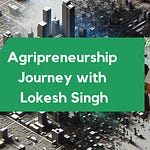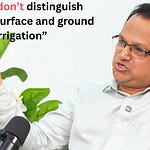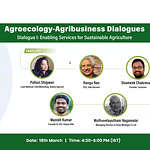Indian Agrifood Systems carry the best and worst of worlds.
On one hand with a fork, we have economists like Tyler Cowen singing hosannas for India’s Food Being the Best in the World:
“Why is the food so good? I have several overlapping hypotheses, most of them coming from my background as an economist. Interestingly, India’s culinary advantages can be traced to some good and some not-so-good aspects of Indian society.
First, food supply chains here are typically very short. Trucking, refrigeration and other aspects of modernity are widespread, but a lot of supply chains are left over from a time when those were luxuries. So if you are eating a vegetable, there is a good chance it came from nearby. That usually means it is more fresh and tastes better.” - Tyler Cowen
On the other hand with a knife, we have a legion of hungry agripreneurs chasing bold futures of Indian Agrifood systems with fire in their belly to attack the shadows of the system that made them best in the world: Fragmentation, informality, and middle-men have long characterized India’s agrifood systems.
While Indian Agriculture remains unsure whether it is a business or not; where time remains the biggest leverage, the past often ends up becoming the heaviest albatross in distorting our agrarian visions of the future.
Can we keep aside our baggage of past and boldly envision the future of Indian agri-food systems?
Can we engage in this exercise with two agri-founders (Alekh-Farmart, Rikin-Digital Green) working on traditional agrarian contexts, albeit dreaming of newer technological possibilities?
Alekh recently shared his goal to “elevate the consciousness of the Food & Agri industry" and also his fundamental conviction when it comes to AI: “The more I think about building companies in the age of AI, the more I believe that low-margin, not-IP-led businesses will have the strongest moats.”
Rikin dreams of Digital Green elevating farmers’ voices thereby engaging with markets with greater equity in 2030.
How do we strive for these bold futures? In the golden words of William Gibson, The future is already here – it's just not evenly distributed. Can we see these emerging, unevenly distributed futures in smallholding contexts?
This conversation was interesting for many reasons. I threw in many googlies and both the founders gamely played on.
How do you articulate a 20-year vision as a founder when investors with ‘impatient capital’ only have a 4-6 year time horizon?
How to navigate the identities of non-profits and for-profits while building technological solutions for Indian Agriculture?
Is Farmart building the next-gen ITC or is ITC busy building the next-gen Farmart?
When you're chasing a big, hairy, audacious problem like extension services in Indian agriculture, how do you navigate the maze of working with the Indian Government and make the necessary trade-offs?
How do you ensure that the company you are building doesn’t end up becoming the centralizing monopoly entity we love to bitch about?
How do you reconcile that AI may eliminate information asymmetry, yet real-world asymmetries would continue to persist in agriculture?
Does the fear of commoditization or trust deficit affect you when you expose your business through DPI to AI/digital layers?
How do you respond to concerns from agri-tech startups about DPI commoditizing their businesses?
We touched on all the hottest topics right now in the world of agricultural technologies: We talked about agentic paradigms that are reshaping the online world for everyone including farmers; We talked about Digital Public Infrastructure, We talked about digitizing FPOs and Cooperatives; We talked about policy recommendations, Capital Stack and lot more.
I hope you enjoy the conversation as much as I did:)
So, what do you think?
How happy are you with today’s edition? I would love to get your candid feedback. Your feedback will be anonymous. Two questions. 1 Minute. Thanks.🙏
💗 If you like “Agribusiness Matters”, please click on Like at the bottom and share it with your friend.











